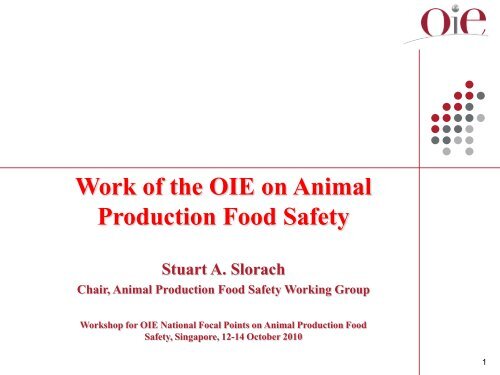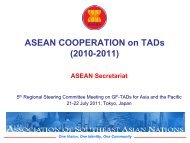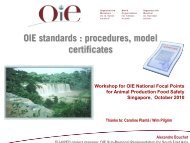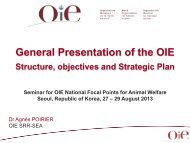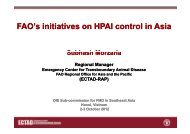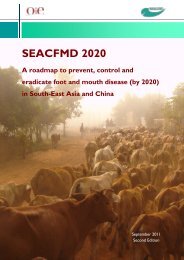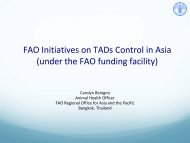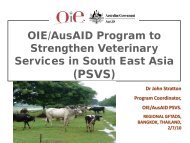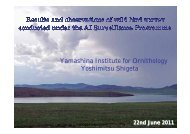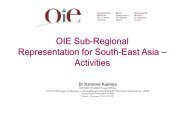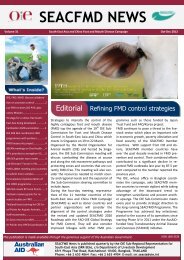Animal Production Food Safety Working Group - OIE Asia-Pacific
Animal Production Food Safety Working Group - OIE Asia-Pacific
Animal Production Food Safety Working Group - OIE Asia-Pacific
You also want an ePaper? Increase the reach of your titles
YUMPU automatically turns print PDFs into web optimized ePapers that Google loves.
Work of the <strong>OIE</strong> on <strong>Animal</strong><br />
<strong>Production</strong> <strong>Food</strong> <strong>Safety</strong><br />
Stuart A. Slorach<br />
Chair, <strong>Animal</strong> <strong>Production</strong> <strong>Food</strong> <strong>Safety</strong> <strong>Working</strong> <strong>Group</strong><br />
Workshop for <strong>OIE</strong> National Focal Points on <strong>Animal</strong> <strong>Production</strong> <strong>Food</strong><br />
<strong>Safety</strong>, Singapore, 12-14 October 2010<br />
1
History of the APFSWG<br />
3 rd <strong>OIE</strong> Strategic Plan (2001-2005) recommended that “<strong>OIE</strong><br />
should be more active in the area of public health and<br />
consumer protection” and noted that “this should include<br />
zoonoses and diseases transmissible to humans via food ,<br />
whether or not animals are affected by such diseases”.<br />
In 2002 the Director General of <strong>OIE</strong> established a permanent<br />
<strong>Animal</strong> <strong>Production</strong> <strong>Food</strong> <strong>Safety</strong> <strong>Working</strong> <strong>Group</strong> (APFSWG)<br />
to coordinate the food safety activities of the <strong>OIE</strong>.<br />
4 th <strong>OIE</strong> Strategic Plan (2006-2010) supports continuation of<br />
this mandate, as does the 5 th <strong>OIE</strong> Strategic Plan (2011-2015)<br />
First WG meeting held December 2002: nine meetings to date.<br />
2
Objectives of the APFSWG<br />
To help to reduce food-borne risks to human health due to<br />
hazards arising from animal production by:<br />
Coordinating <strong>OIE</strong> activities related to animal production food<br />
safety, which have the goal of “reducing food-borne risks to<br />
human health by preventing, eliminating or controlling<br />
hazards arising from animals prior to primary processing of<br />
animals and animal products”<br />
Providing advice to the Director General and the <strong>OIE</strong><br />
Specialist Commissions<br />
Strengthening cooperation between the <strong>OIE</strong> and the Codex<br />
Alimentarius Commission (CAC) and its subsidiary bodies to<br />
avoid duplication and overlap and to address gaps in standards.<br />
3
Membership of the APFSWG<br />
Members proposed by <strong>OIE</strong> Director General and endorsed by<br />
the <strong>OIE</strong> World Assembly of Delegates.<br />
Based on scientific expertise, with balanced geographical<br />
representation as an important secondary consideration.<br />
Experts expected to contribute objectively to discussions and<br />
not represent the views of a particular country, section or<br />
organisation.<br />
4
Membership of APFSWG<br />
Members: Prof. H. Aidaros (Egypt), Dr C.A. Correa Messuti<br />
(Uruguay), Dr K. de Balogh (FAO), Dr S. Doyran (CAC<br />
Secretary), Dr D. Lo Fo Wong (WHO), Dr A. McKenzie (New<br />
Zealand), Dr A. Randell (Italy), Mr M. Scannell (European<br />
Commission) , Dr S. Slorach (Sweden), Dr R. S.Thwala<br />
(Swaziland)<br />
Other participants and observers: Dr A.Thiermann<br />
(President of the <strong>OIE</strong> Terrestrial <strong>Animal</strong> Health Standards<br />
Commission), Dr K. Huleback (Chairperson of the CAC)<br />
<strong>OIE</strong> Headquarters: Dr B. Vallat, Dr S. Kahn, Dr G. Mylrea<br />
and other staff from the <strong>OIE</strong> International Trade Department<br />
(Secretariat) and staff from other <strong>OIE</strong> Departments.<br />
5
Terms of Reference (1)<br />
APFSWG’s Terms of Reference include:<br />
Consideration of all food-borne hazards arising from animals<br />
before slaughter<br />
Primary focus on food safety measures applicable at farm level<br />
Consideration of food safety measures applicable elsewhere,<br />
e.g. during animal transport & harvesting wild animals<br />
Work priorities that take into account global food safety<br />
priorities of relevant internat. orgs., esp. CAC, FAO and WHO<br />
Taking into account food safety standards developed and<br />
under development by relevant international organisations,<br />
especially the CAC<br />
6
Terms of Reference (2)<br />
Support for the work of the <strong>OIE</strong> Specialist Commissions on<br />
pre-slaughter animal production food safety<br />
Advising <strong>OIE</strong> DG on all issues related to APFS, for example:<br />
- establishing ad hoc <strong>Group</strong>s to address specific tasks<br />
- linking at the working level with CAC, FAO and WHO<br />
- ensuring pre-slaughter APFS is integrated in Specialist<br />
Commissions’ and ad hoc <strong>Group</strong>s’ activities<br />
- providing technical input into work of Specialist Commiss.<br />
- enhancing communications, information sharing and<br />
consultation<br />
- issues related to good governance, incl. veterinary education<br />
7
APFSWG Priorities<br />
Identifying and addressing gaps, contradictions, areas where<br />
harmonisation is necessary and duplications in the work of<br />
<strong>OIE</strong> and other international/intergovernmental organisations<br />
involved in food safety standards, in particular CAC.<br />
Strengthening relationship with other relevant scientific and<br />
normative organisations working on food safety, in particular<br />
CAC, FAO and WHO.<br />
Improving coordination between competent authorities with<br />
animal health and food safety responsibilities at the national<br />
and regional levels.<br />
Recommending a work programme to address the mandate of<br />
the <strong>OIE</strong> on animal production food safety<br />
8
Main issues dealt with (1)<br />
1. Horizontal issues<br />
Meat inspection<br />
Role of the Veterinary Services in food safety<br />
Guide to good farming practices<br />
<strong>Animal</strong> identification and traceability<br />
Certification, model certificates<br />
<strong>Animal</strong> feeding<br />
Anti-microbial resistance<br />
Biotechnology<br />
9
Main issues dealt with (2)<br />
2. Disease-specific <strong>OIE</strong> texts<br />
Bovine tuberculosis<br />
Bovine brucellosis<br />
Salmonellosis<br />
Campylobacteriosis<br />
3. Cooperation between the Codex Alimentarius Commission<br />
and the <strong>OIE</strong><br />
10
Meat inspection<br />
The Codex Alimentarius Code of Hygienic Practice for Meat<br />
constitutes the primary international standard for meat hygiene<br />
and incorporates a risk-based approach to the application of<br />
sanitary measures throughout the meat production chain.<br />
APFSWG developed <strong>OIE</strong> text to complement this Code.<br />
After going through the usual <strong>OIE</strong> procedure, a text was<br />
adopted and incorporated into the Terrestrial <strong>Animal</strong> Health<br />
Code as Chapter 6.2. Control of biological hazards of animal<br />
and public health importance through ante- and post-mortem<br />
meat inspection.<br />
(More information in a separate presentation tomorrow)<br />
11
Guide to good farming practices<br />
<strong>OIE</strong>-FAO Guide to Good Farming Practices for <strong>Animal</strong><br />
<strong>Production</strong> <strong>Food</strong> <strong>Safety</strong> (GGFP). Initiated by APFSWG and<br />
further developed by an ad hoc <strong>Group</strong>. Text finalised in 2008<br />
and published in the <strong>OIE</strong> Bulletin (2008-3).<br />
GGFP is designed to minimise animal health and food safety<br />
risks arising at the farm level during animal production.<br />
GGFP comprises sections on hazards and corresponding<br />
control points, general farm management, animal health<br />
management, veterinary medicines and biologicals, animal<br />
feeding and watering, environment and infrastructure, animal<br />
and product handling and implementation.<br />
12
<strong>Animal</strong> identification and<br />
traceability<br />
APFSWG has been involved in the development of <strong>OIE</strong><br />
Terrestrial <strong>Animal</strong> Health Code Chapter 4.2 Design and<br />
Implementation of Identification Systems to Achieve <strong>Animal</strong><br />
Traceability, which was adopted in 2008.<br />
<strong>OIE</strong> organised an International Conference on <strong>Animal</strong><br />
Identification and Traceability , which was held in Buenos<br />
Aires on 23-25 March 2009.<br />
APFSWG will review texts developed in response to relevant<br />
recommendations from that conference.<br />
13
Certification, Model Certificates<br />
APFSWG has been involved in the development of <strong>OIE</strong><br />
Model Certificates, including Terrestrial <strong>Animal</strong> Health Code<br />
Chapter 5.10 Model Veterinary Certificates for International<br />
Trade in Live <strong>Animal</strong>s, Hatching Eggs and Products of <strong>Animal</strong><br />
Origin , which was adopted in 2008<br />
APFSWG emphasises need for close cooperation between the<br />
work of the <strong>OIE</strong> and work on certification carried out by the<br />
Codex Committee on <strong>Food</strong> Import and Export Inspection and<br />
Certification Systems (CCFICS).<br />
APFSWG will monitor developments in certification, in<br />
particular electronic certification, in CAC, <strong>OIE</strong>, etc.<br />
14
<strong>Animal</strong> feed<br />
Following a recommendation from APFSWG, an ad hoc<br />
<strong>Group</strong> drafted a text on Control of Hazards of <strong>Animal</strong> Health<br />
and Public Health Importance in <strong>Animal</strong> Feed, to complement<br />
the Codex Guidelines on Good <strong>Animal</strong> Feeding. Separate texts<br />
for terrestrial and aquatic animal feed were then developed.<br />
The text on feed for terrestrial animals (Ch. 6.3. in the<br />
Terrestrial <strong>Animal</strong> Health Code) was adopted in 2009 and<br />
revised in 2010.<br />
In November 2010 APFSWG reviewed a draft text on feed for<br />
aquatic animals: the revised text was adopted in May 2010<br />
A text on heat-treated pet food is being developed.<br />
(More info. on animal feed in separate presentation tomorrow)<br />
15
Antimicrobial resistance<br />
WG is kept updated on <strong>OIE</strong>, Codex, FAO and WHO work<br />
Codex ad hoc Intergovernmental Task Force on Antimicrobial<br />
Resistance has developed Proposed draft guidelines for risk<br />
analysis of foodborne antimicrobial resistance, which was<br />
adopted by CAC in 2010 at Step 5 of the Codex procedure<br />
Aquatic Code Commission is developing texts for the Aquatic<br />
<strong>Animal</strong> Health Code addressing antimicrobial resistance issues<br />
similar to Chapters 6.6 – 6.10 in the Terrestrial Code<br />
APFSWG encourages <strong>OIE</strong> to continue to engage closely with<br />
Codex, FAO, WHO and VICH on the important topic of<br />
antimicrobial resistance<br />
16
Biotechnology<br />
<strong>OIE</strong> ad hoc <strong>Group</strong> on Biotechnology has been divided into<br />
two separate groups, one focussing on vaccinology and the<br />
other on molecular diagnostic tests.<br />
Priority issues for the ad hoc <strong>Group</strong> on vaccinology will be the<br />
use of biotechnology-derived vaccines on animals and <strong>OIE</strong><br />
will first consider animal health implications and then the food<br />
safety implications of the use of this technology<br />
Codex has requested that <strong>OIE</strong> address the issue of possible<br />
food safety implications of biotechnology-derived vaccines in<br />
food-producing animals.<br />
APFSWG considered that broad scientific expertise is needed<br />
to address this issue and recommended that <strong>OIE</strong>, FAO and<br />
WHO all be involved in this work.<br />
17
Disease-specific texts<br />
APFSWG has reviewed a number of texts on bovine<br />
tuberculosis, bovine brucellosis and salmonellosis intended for<br />
incorporation into the Terrestrial <strong>Animal</strong> Health Code.<br />
APFSWG reviewed a draft Terrestrial Code Chapter on<br />
Prevention, detection, control of Salmonella in poultry and<br />
recommended inclusion of an additional text on eradicating (or<br />
significantly reducing) Salmonella Enteritidis from eggproducing<br />
flocks. Final text was adopted in May 2009 and<br />
revised in 2010. (More information tomorrow)<br />
<strong>OIE</strong> continues to collaborate closely with Codex Committee<br />
on <strong>Food</strong> Hygiene on work on salmonellosis and<br />
campylobacteriosis, in particular in poultry meat.<br />
18
Standard setting for foodborne pathogens<br />
First step: Ad hoc <strong>Group</strong> on Parasitic Diseases, 5-7 October,<br />
2010<br />
Discuss on <strong>OIE</strong> listed pathogens:<br />
‣ Echinococcus granulosus and Trichinella sp. (existing chapters),<br />
‣ a new chapter on the listed pathogen<br />
• Cysticercus Cellulosae (Taenia solium)<br />
Advise on the possible future need for the <strong>OIE</strong> to provide<br />
advice (outside the Terrestrial Code) on the unlisted pathogen,<br />
Cysticercus Bovis (Taenia saginata).<br />
19
Future work<br />
In addition to the horizontal and disease-specific issues<br />
mentioned above, APFSWG work programme for 2010<br />
includes the following issues:<br />
• Follow-up of report by Dr Knight-Jones on priority pathogens<br />
for <strong>OIE</strong> standard setting in APFS<br />
• Revision of <strong>OIE</strong> Handbook on Import Risk Analysis<br />
• APFS in veterinary education following recommendations<br />
from the <strong>OIE</strong> conference held in October 2009<br />
• Scientific evidence on relationship between animal welfare<br />
and APFS<br />
• Policy statement on the importance of APFS for food security<br />
20
Further information<br />
Further information about the <strong>Animal</strong> <strong>Production</strong> <strong>Food</strong> <strong>Safety</strong><br />
<strong>Working</strong> <strong>Group</strong>, including its membership, modus operandi<br />
and the reports of all its meetings, can be obtained by going to<br />
the <strong>OIE</strong> website (www.oie.int) and clicking on “<strong>Food</strong> <strong>Safety</strong>”<br />
The <strong>OIE</strong> Terrestrial <strong>Animal</strong> Health Code and Aquatic <strong>Animal</strong><br />
Health Code can also be accessed via the <strong>OIE</strong> website<br />
New developments in the food safety area are also reported in<br />
the <strong>OIE</strong> Bulletin<br />
Codex documents can be accessed via the Codex website<br />
(www.codexalimentarius.net) or obtained via your national<br />
Codex Contact Point (contact details on the Codex website)<br />
21


